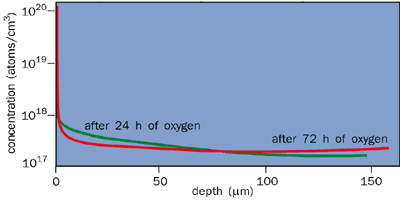The Rose collaboration (RD48: R&D on silicon for future experiments) at CERN has tackled the same problem as RD39,
from a different angle but with similar success. Its approach is “defect engineering”: the careful control of impurities particularly carbon and oxygen in the silicon lattice.

Just as steel embedded in concrete has a dramatic effect on the properties of the finished product, so impurities in silicon can change the behaviour of silicon detectors. In 1996 the Rose collaboration set out to test the hypothesis that carbon and oxygen impurities, in particular, would improve the radiation tolerance of silicon, allowing it to be used for detectors in the LHC.
Oxygen and carbon were chosen because, according to models of radiation damage, oxygen should “capture” vacancies in the silicon lattice and carbon should capture silicon interstitials. Also, oxygen and carbon are always present to some extent in detector-grade silicon, making them prime candidates for further studies. This capturing effect would then render the lattice defects inactive, just as extreme cold does in the Lazarus effect. Unlike the Lazarus effect, however, silicon detectors made radiation-hard through defect engineering could be operated with only moderate cooling.
More than a dozen samples of silicon doped to various degrees with carbon and oxygen were studied while undergoing irradiation corresponding to the full lifetime of a detector in the LHC. While not entirely agreeing with model predictions,
the results were encouraging. Carbon in the silicon lattice diminishes performance, while oxygen improves radiation hardness to a greater degree than foreseen.

The strength of the effect with oxygen was not the only unexpected outcome. As part of the Rose programme, samples were irradiated with different kinds of particle: neutrons, protons and pions. At the LHC, the radiation that traverses the detectors closest to the beam pipe is expected to consist mainly of pions, but, further away from the initial collision, neutrons will become more important.
The results show a performance improvement of a factor of three for strongly interacting charged particles in oxygenated detectors, compared with those of standard silicon detectors. Curiously, no improvement is seen for detectors irradiated by neutrons. However, because in most situations charged particles make up a substantial fraction of the radiation environment, the improvement in performance for charged particles is welcome. Moreover, a simple method has been found to diffuse oxygen into any silicon wafer prior to, or during, processing, and this is being transferred to detector manufacturers. Experiments such as DESY’s HERA-B, which replaces its silicon detectors each year, should be among the first to benefit.
Detectors are not the only place where solutions to such problems are needed. In the electronics industry, limitations with ion-implantation techniques are holding up progress in transistor miniaturization. In response to this problem, the EU supports the European Network in Defect Engineering of Advanced Semiconductor Devices (ENDEASD), which is linked to the Rose collaboration. ENDEASD combines a range of academic institutions and semiconductor manufacturers, bringing much extra expertise and knowledge to the complicated subject of radiation effects.
Given the success of both the Lazarus and Rose collaborations, the obvious question to ask is whether an even higher performance could be achieved by combining the two techniques. This is high on the agenda for both collaborations and will be investigated this year. LHC experiments are already preparing to put out invitations to tender for their tracking detectors, so for Lazarus and Rose the timescale to produce working detectors is tight. However, with the progress made so far, even at temperatures below 100 K, both collaborations are confident that the future for silicon looks rosy.








